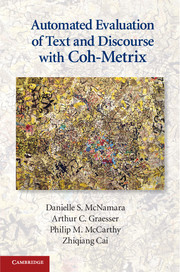Book contents
- Frontmatter
- Dedication
- Contents
- List of Figures
- List of Tables
- Acknowledgments
- Introduction
- Part I Coh-Metrix
- Part II A Beginner’s Guide to Writing Coh-Metrix Research
- 7 The Strategy
- 8 The Introduction
- 9 The Corpus
- 10 The Tool
- 11 The Results
- 12 The Discussion
- Concluding Remarks
- References
- Appendix A Coh-Metrix 3.0 Indices
- Appendix B Coh-Metrix Indices Norms
- Index
11 - The Results
Published online by Cambridge University Press: 05 June 2014
- Frontmatter
- Dedication
- Contents
- List of Figures
- List of Tables
- Acknowledgments
- Introduction
- Part I Coh-Metrix
- Part II A Beginner’s Guide to Writing Coh-Metrix Research
- 7 The Strategy
- 8 The Introduction
- 9 The Corpus
- 10 The Tool
- 11 The Results
- 12 The Discussion
- Concluding Remarks
- References
- Appendix A Coh-Metrix 3.0 Indices
- Appendix B Coh-Metrix Indices Norms
- Index
Summary
The Results section in a research paper is generally the last section to get started but it is often the first section to get finished. That is, once you have collected your data (the corpus), you’ll need to analyze it, and once you’ve analyzed it, it is a relatively simple task to write it up. It is a relatively simple task to write it up because the results section is (or least can be) highly formulaic. Indeed, some software (e.g., the Gramulator; McCarthy, Watanabi, & Lamkin, 2012) actually conducts statistical analyses and automatically outputs an acceptable (if highly formulaic) results section.
As in Chapters 8, 9, and 10, this chapter looks at the writing process for a short Coh-Metrix paper in terms of moves and frozen expressions. We will also look briefly at the meaning of those strange letters and numbers that are the main feature of the results section (the t’s, p’s, d’s, etc.). We have made every effort to make this chapter as accessible as possible, assuming that the reader is relatively new to reporting statistical results; however, as mentioned at the beginning of Part II, we have also assumed that the reader has some statistical knowledge. Therefore, the reader should be aware that it is beyond the scope of this book to explain in any great depth what statistics are, which kinds of statistics are appropriate for which kinds of analyses, how statistics work, how they are calculated, how they should be interpreted, and how they are often misinterpreted. To address questions such as these in more detail, there are excellent resources available, such as the textbooks SPSS Made Simple (Kinnear & Gray, 2008) and SPSS for Intermediate Statistics: Use and Interpretation (Leech, Barrett, & Morgan, 2008). There are also excellent Web resources such as www.talkstats.com and http://vassarstats.net.
Information
- Type
- Chapter
- Information
- Automated Evaluation of Text and Discourse with Coh-Metrix , pp. 176 - 193Publisher: Cambridge University PressPrint publication year: 2014
